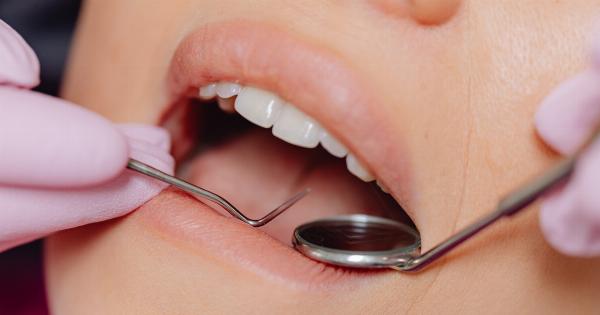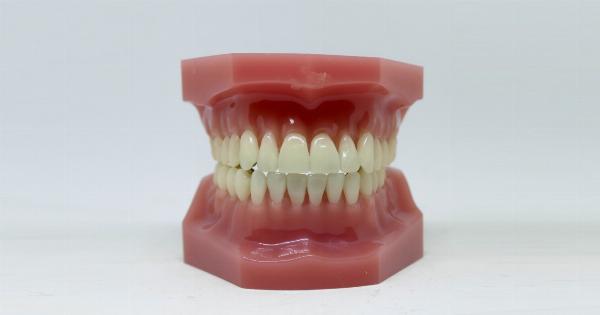Dental damage is a common occurrence that can affect people of all ages. It refers to any injury or harm to the teeth, gums, or surrounding structures in the oral cavity.
This damage can range from mild to severe, depending on the cause and extent of the injury. Understanding the causes, types, and treatments for dental damage is essential for maintaining good oral health. In this article, we will explore everything you need to know about dental damage.
Causes of Dental Damage
There are several factors that can lead to dental damage. Some of the most common causes include:.
1. Accidents and Trauma
Accidents, such as falls, sports injuries, or car accidents, can result in dental damage. This may include tooth fractures, chips, or even complete avulsion (knocked-out teeth).
Trauma to the face can also cause damage to the jawbone or temporomandibular joint (TMJ).
2. Tooth Decay
Tooth decay, also known as dental caries or cavities, is a common cause of dental damage. It occurs when bacteria in the mouth produce acids that erode the enamel, leading to the formation of cavities.
If left untreated, tooth decay can progress and cause more significant damage, such as toothache or abscess formation.
3. Gum Disease
Gum disease, also called periodontal disease, is an infection of the gums and supporting tissues around the teeth. It is usually caused by poor oral hygiene, which leads to the buildup of plaque and tartar.
If left untreated, gum disease can progress and result in gum recession, tooth loss, and bone damage.
4. Bruxism
Bruxism is a condition characterized by teeth grinding or clenching, often during sleep. This habit can exert excessive force on the teeth, leading to enamel wear, tooth sensitivity, and even fractures.
Over time, bruxism can cause significant dental damage and also contribute to temporomandibular joint disorders.
Types of Dental Damage
There are various types of dental damage that can occur as a result of the above causes. These include:.
1. Dental Fractures
Dental fractures refer to cracks or breaks in the teeth. There are different types of dental fractures, such as:.
• Craze lines: Superficial cracks in the enamel that do not usually cause pain or structural damage.
• Enamel fractures: Deeper cracks that affect the enamel’s integrity but do not extend into the underlying layers of the tooth.
• Cracked tooth: A crack that extends from the chewing surface of the tooth towards the root. This type of fracture can cause pain and may require treatment to prevent further damage.
• Split tooth: A severe type of fracture where the tooth splits into separate segments. In most cases, the affected tooth cannot be saved and requires removal.
• Vertical root fracture: A crack that starts in the root of the tooth and extends towards the crown. This type of fracture often goes unnoticed as it may not cause significant symptoms.
2. Tooth Displacement
Tooth displacement refers to the abnormal positioning of teeth due to external forces or trauma. It includes:.
• Intrusion: When a tooth is pushed into the jawbone, causing it to appear shorter than the surrounding teeth.
• Extrusion: When a tooth is partially pushed out of its socket, causing it to appear longer than the adjacent teeth.
• Luxation: When a tooth is pushed sideways or becomes loose due to trauma.
3. Avulsion
Avulsion occurs when a tooth is completely knocked out of its socket due to trauma. Immediate dental intervention is crucial for successfully reimplanting the avulsed tooth.
4. Enamel Erosion
Enamel erosion refers to the loss of the outermost layer of the tooth due to acid attack. It can occur as a result of excessive consumption of acidic foods and beverages or as a complication of certain medical conditions.
5. Gum Recession
Gum recession is the gradual loss of gum tissue, which leads to the exposure of tooth roots. It can occur due to gum disease, aggressive brushing, or genetic factors. Gum recession can make teeth appear longer and more sensitive to hot or cold stimuli.
Treatment Options for Dental Damage
The treatment for dental damage depends on the type and severity of the injury. Some common treatment options include:.
1. Dental Fillings
If tooth decay has caused damage to the enamel, a dental filling may be necessary. The decayed portion of the tooth is removed, and a filling material (such as composite resin or amalgam) is used to restore the tooth’s shape and function.
2. Root Canal Therapy
Root canal therapy is performed when dental damage extends to the innermost layer of the tooth, known as the pulp. During this procedure, the infected or damaged pulp is removed, and the space is filled with a biocompatible material.
A crown is usually placed on top to protect the tooth and restore its strength.
3. Dental Crowns
Dental crowns are used to restore extensively damaged or weakened teeth. These custom-made caps cover the entire visible portion of the tooth, providing strength and protection.
Crowns can be made from various materials, including porcelain, metal, or a combination of both.
4. Dental Implants
If a tooth has been completely knocked out (avulsion) or needs to be extracted due to severe damage, a dental implant may be recommended. A dental implant is an artificial tooth root that is surgically placed into the jawbone.
It serves as a stable foundation for a dental crown, bridge, or denture.
5. Orthodontic Treatment
Orthodontic treatment, such as braces or aligners, may be necessary to correct dental damage resulting from tooth displacement or malocclusion.
These appliances help move the teeth into their proper positions, improving both the appearance and functionality of the smile.
Preventing Dental Damage
While accidents can happen, there are several preventive measures you can take to reduce the risk of dental damage. These include:.
1. Maintain Good Oral Hygiene
Brush your teeth at least twice a day with a fluoride toothpaste, floss daily, and rinse with an antibacterial mouthwash. Regular dental check-ups and professional cleanings can help detect and prevent early signs of dental damage.
2. Wear Mouthguards
If you participate in contact sports or recreational activities with a risk of facial injury, wearing a mouthguard can help protect your teeth and gums. Custom-fitted mouthguards offer the best protection.
3. Avoid Bad Habits
Avoid habits like nail biting, chewing on ice, or using your teeth as tools. These habits can increase the risk of dental damage.
4. Address Teeth Grinding
If you grind your teeth at night, known as bruxism, it is essential to address this habit. Your dentist may recommend wearing a nightguard to protect your teeth and alleviate the pressure on the jaw joint.
5. Limit Acidic Foods and Drinks
Acidic foods and beverages, such as citrus fruits, carbonated drinks, and vinegar-based foods, can contribute to enamel erosion. Limiting their consumption and rinsing your mouth with water afterward can help protect your teeth.
Conclusion
Maintaining good oral health and preventing dental damage is crucial for a healthy and beautiful smile. By understanding the causes, types, and treatment options for dental damage, you can take proactive steps to protect your teeth and gums.
Remember to follow a consistent oral hygiene routine, visit your dentist regularly, and seek prompt treatment if you experience any signs of dental damage. Taking care of your dental health now can save you from potential pain, discomfort, and extensive dental procedures in the future.


























